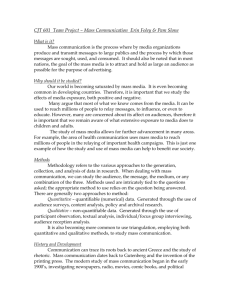RUNNING HEAD: SPIRITUAL USES AND GRATIFICATIONS
advertisement
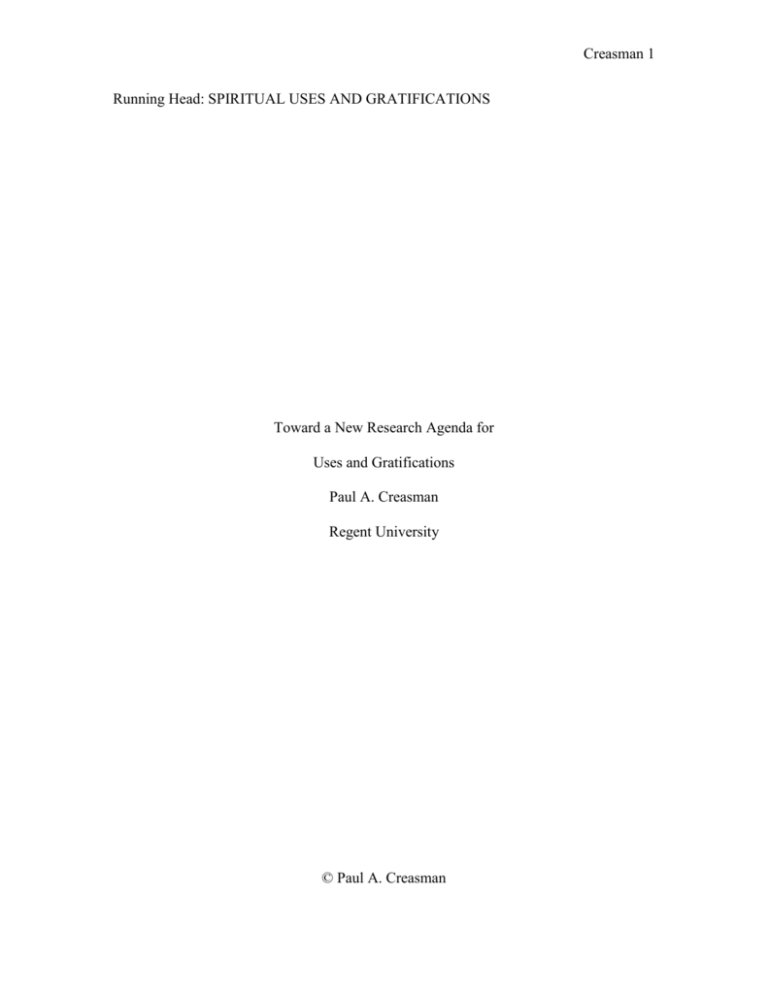
Creasman 1 Running Head: SPIRITUAL USES AND GRATIFICATIONS Toward a New Research Agenda for Uses and Gratifications Paul A. Creasman Regent University © Paul A. Creasman Creasman 2 TOWARD A NEW RESEARCH AGENDA FOR USES AND GRATIFICATIONS In their 1996 article “The Category of the Religious: The Blindspot of Contemporary Media Theory,” Hoover and Venturelli claimed “understandings of the processes of meaning construction are incomplete without attention to the range of sentiments and sensibilities we call ‘beliefs.’” To exclude the notion of spirituality from media inquiry “leaves us only partly the wiser” (p. 251). As part of their argument, they proposed that religion and spirituality are inexorably interwoven with cultural life, and in today’s society mediated forms of communication dominate cultural life (p. 251). It is the purpose of this essay to respond to Hoover and Venturelli’s call for “the development of method which could contemplate religious and media practice in these terms” (p. 259). The uses and gratifications tradition historically has been employed to account for “individual mass media consumption,” that is, “audience members’ choices of exposure to various media types and types of media content” (Palmgreen, 1984, p. 22). With an increasing presence of spirituality in the media, the uses and gratifications approach would seem to be a logical theoretical perspective to adopt in order to explore what spiritual benefits individual consumers of such media receive. It is argued here, however, that the current definitions of spirituality and religiosity used in uses and gratifications research is inadequate, or at least, yields a limited view of the range of potential gratifications received from religious media and explains even less why audience members consumer religious media. Indeed, few uses and gratifications studies of religious media have been published in the recent literature. In fact, if one takes the number of published studies as an indicator, spirituality in the media as a topic of scholarly inquiry has been marginalized for much of the 1990s—despite spirituality’s increased presence in the media. Notable exceptions do exist (Engnell, 1995; Romanowski, 1992; Reid, 1993), but on the whole, scholarly research has not kept pace with the exponential increase of Creasman 3 spirituality in the media. The remainder of this essay will highlight examples of spirituality in today’s media climate, review the uses and gratifications literature showing where it fails to capture full the scope of spirituality, and finally, advance new variables for inclusion into further uses and gratifications examinations of spiritually-saturated media. The Next Awakening in America? Hoover and Venturelli (1996) claimed “the category of the religious has asserted itself in media discourse to an almost unprecedented degree” (p. 251). This is ever more true as we approach the millennium. Overall, the spiritual climate of the United States appears to be peaking, (or piquing) as the year 2000 draws closer. Paquette (1998) reflecting on the spiritual climate of 1997 wrote, “Americans appeared gripped in an inchoate spiritual revival that transcended traditions and institutions” (E-4). Kleiner (1999) noted how enrollment at Christian colleges and universities was booming, growing by 24 percent from 1990 to 1996, as compared to only 4 percent growth over the same period for public institutions (p. 60). Beaudoin (1998) perhaps made the strongest statement concerning the re-emergence of God as a subject of mediated discourse: While spiritual themes often appear in American culture, an important shift is occurring. For a generation widely presumed to be indifferent to religion, religious themes and images are strikingly prevalent. It may be overstating things to declare that God is on everyone’s mind, but God—or at least a quest for meaning beyond the world of banality—is nearly a mainstream topic. (p. 42) Certainly in popular culture, artifacts abound that testify to a renewed interest in spirituality. In television, Touched by an Angel is the first series since 1991 to last more than one year that blatantly incorporates spiritual themes into its plot lines (Schindler, 1997, pp. 4041). In 1997, Touched by an Angel garnered a 13.3 rating and a 20 share, making it one of the Creasman 4 highest rated dramatic shows on television that year (Rice, 1997, p. 26). Book publishing is noting increased attention to spiritual issues. While Hal Lindsay’s The Late Great Planet Earth set the early standard for spiritual book sales in the 1970s, selling 20 million copies (Di Sabatino, 1999, p. 13), Carrigan (1995) noted a “marked increase in requests for religious and spiritual books” toward the end of the decade and into the next (p. 36). Religious book sales are projected to increase by eighty-two percent between 1987 and 2010 (p. 37). One of the most popular fiction series published today is the evangelical series Left Behind, by theologian Tim Lahaye and wordsmith Jerry Jenkins. The six books in the series, telling of a post-rapture earth, have sold more than 10 million copies since they debuted in 1995 (Murphy, 1999, p. C1). Publishers Weekly noted the series currently sells an average of 1.1 million copies a month (cited in Halls, 1999, p. I-1). Perhaps the single best indicator of spirituality’s resurgence in popular media is the growth of contemporary Christian music. Contemporary Christian music (CCM) developed during the Jesus movement era of the late 1960s as a form of cultural evangelism (Romanowski, 1992). Throughout much of its history, CCM was ghettoized and far removed from mainstream pop music circles. In the 1990s, however, CCM has emerged as a forceful genre. Since 1991, the CCM genre has averaged 22% growth a year (Zimmerman, 1996, p. 6D). In 1996, CCM record sales totaled $538 million (Price, 1997, p. 45). By 1998, combined sales of records and concert tickets totaled $1.3 billion (Sandler, 1998, p. 32). Bolstered by the successes of Amy Grant and Michael W. Smith, sales of CCM by mainstream outlets increased 40% between 1992 and 1993 (Gubernick & Franco, 1995, p. 40). There is overwhelming evidence, much more so than the mere “fundamentalism and the emergence of various religious practices of ‘New Age’” that inform the Hoover and Venturelli essay (1996, p. 258), that spirituality is alive and well in today’s media climate. The Creasman 5 question that remains is “Do we have an adequate methodological and theoretical paradigm by which we can evaluate such media use?” I argue that the past and current uses and gratifications research indicates that academia does not. McQuail (1984) stated that the uses and gratifications approach focuses on the choice of the audience which “requires a sensitivity to the full range of meanings of that experience” (p. 183). For uses and gratifications theory to capture that full range of experience for the spiritual media consumer, a re-conceptualization of the variable “spirituality” must be considered. We now turn our attention to an examination of the uses and gratifications literature to see how the variable “spirituality” has been utilized and operationalized in the past. Uses and Gratifications Research and Spirituality The history of uses and gratifications research has been recounted many times in the literature (e.g., McLeod & Becker, 1981; McQuail, 1984; Rosengren, Wenner, & Palmgreen, 1985). Two items inherent in the approach bear emphasis here—first, the theory’s focus on the individual audience member, and second, the rational characteristics of the audience member. Katz (1959) provided the necessary push toward an audience-centered line of research when he wrote, “…less attention [should be paid] to what media do to people and more to what people do with media” (p. 2). Up until the late 1940s, most media research was focused on “uniform” or “direct effects” (Woods, 1999, p. 53). It was widely held that people were powerless to resist media messages. Klapper (1960) began to formalize the existence of intervening effects, which began to dismantle the dominant powerful effects paradigm. McQuail (1984) noted the change this idea brought to media studies: The guiding thought was that effects would be more likely to occur where a corresponding or relevant motive existed on the part of the receiver. In turn, this had a place in the development of theory and research concerning the active or Creasman 6 ‘obstinate’ audience and of interactive, in place of one-way, models of media influence. (p. 179) The active audience, who select media to consume for the purpose of meeting specific goals, has remained a key tenant to the uses and gratifications paradigm (Katz, Blumler & Gurevitch, 1973, p. 510; McQuail, 1984, p. 185). Hand in hand with the active audience concept is the rational audience concept. McQuail (1984) noted uses and gratifications involved “a view of media consumption as a logical and sequential process” (p. 185). The rational audience is primarily a methodological concern for uses and gratifications, for most research in the area involves self-reporting of gratification needs. Becker (1979) wrote, “It must be assume that the respondent is capable of providing answers to the questions posed regarding relevant gratifications” (p. 56). Uses and gratifications as a research paradigm has been heavily criticized by media scholars (e.g., Elliot, 1974; Swanson, 1977). Most notably, critics charge that uses and gratifications lack a theoretical basis for its claims, that it is overly functional, or positive, in its view of media, and it never gets beyond normative claims of media use—in other words, it fails in its ability to predict media use (Katz, Blumler, & Guervitch, 1973; McLeod & Becker, 1981). One could say this present essay adds to the number of dissenting voices about uses and gratifications, for it is held here that the major tenants discussed above, the focus on the rational and individual media consumer, are problematic for examinations of spiritual uses and gratifications. This is not to say uses and gratifications should be eliminated as a research paradigm, for many have noted its usefulness and powerful capabilities to explain media consumption (e.g., McQuail, 1984, p. 185; Palmgreen, 1984). I am merely advocating a reconceptualization of certain aspects of the approach as they relate to spiritual media consumption. Before I illuminate the specific problems with spirituality as used in uses and Creasman 7 gratifications research, it will be helpful to examine how spirituality has been approached in past gratifications research. Uses and Gratifications of Religious Media Abelman perhaps undertook the most well known examinations of spiritual gratifications derived from media. In a series of studies (1987, 1988, 1989) he investigated uses of televangelism by the religious media audience. Drawing on the work of Rubin (1984), Abelman identified ritual and instrumental viewers among the religious television audience— that is, religious audiences view religious television out of habit and a need to stay informed. Interestingly, Abelman also identified a third view type, the reactionary viewer. The reactionary viewer consumes religious television primarily as an alternative to secular media (1987, p. 304). This viewer is largely dissatisfied with the offerings of commercial television and views religious programming to gain a sense of “moral support not found in secular programming” (p. 304). What is intriguing about these studies is their failure to identify any unique spiritual gratification of religious programming. The reactionary viewer, according to Abelman, is “not unique to religious television” (1987, p. 304; 1988, p. 164). The motives of this type of viewer are actually rooted in secularism, rather than in spirituality. Abelman makes the claim that these viewers seek spiritual guidance and moral support, but fails to illuminate the religious roots of these needs. No mention is given to the potential network of beliefs that may have informed the need for “guidance.” He also fails to clearly associate morality with spirituality. If morality is to be known as an axiological framework for rational decision making, nowhere does Abelman connect such decisions with a sense of spirituality. In fact, in Abelman’s third study (1989), the reactionary viewer disappeared in the final analysis (p. 63). Creasman 8 As with most gratification studies, the normative typologies used to measure the gratifications were drawn from known examinations of “secular” media. No consideration is made as to whether the gratification typologies are uniquely spiritual or not. Abelman weakly defines one of his main typologies—religiosity—as “the importance religion has in one’s life” (1987, p. 305; 1988, p. 116), and we come away from the studies still not knowing how spirituality informs media choices. In his first study, Abelman argued that “religious programming has been ignored” in gratifications research (1987, p. 294). In can be said that while these studies at least pay attention to religious media, we still don’t have any better idea of what people are seeking spiritually from religious programming. Other studies of gratifications received from religious media suffer from problems of definition as well. Buddenbaum (1981) provided a mostly normative demographic description of the religious television audience. Of two need variables that were significant, “knowing one’s self” and “avoiding loneliness,” Buddenbaum fails to explain why they are considered religious needs. She hints briefly (p. 269) that these needs and religion are directly correlated and may be unique, but the resulting statistical correlations are weak. Gaddy and Pritchard (1985), in their examination of religious television as a functional alternative to physical attendance at a worship service, defined religiosity in terms of “the religious attitudes, values, and beliefs an individual holds” (p. 129). While religiosity was seen as an important factor in the analysis, this definition still does not give additional insight as to the attributes and characteristics of spirituality. These examples lead me to propose a new way of constructing a variable for spirituality. Others have noted the difficulty in operationalizing such an abstract concept. Korpi and Kim (1986) lament: Creasman 9 Uses and gratifications researchers often tend to resort to socio-structural variables such as standard demographics, especially age, sex, income, education, and occupation, availability of leisure time and media channels. They also resort to psychological variables such as needs and motives. However, these two kinds of variables (socio-structural and psychological) provide at best indirect explanations of why people attend to media. (p. 412). The above studies from Buddenbaum, Gaddy and Pritchard, and Abelman seem to fit this description and are no better at developing an advanced understanding of religiosity and spirituality than Hamilton and Rubin (1992). They defined religiosity in terms of church affiliation (p. 671) in a study that admittedly had nothing to do with spiritual gratifications. Is this the best understanding of spiritual gratifications our field can muster? Perhaps it is time to move away from such socio-structural and psychological variables uses and gratifications has relied upon and look to other areas for “inspiration” concerning “spirituality.” Defining Spirituality for Uses and Gratifications Study A major reason I propose for the failing of current uses and gratifications examinations to properly account for spirituality is its over-dependence upon the individual as the object of study. Note, I said the individual, not the audience. Uses and gratifications research must be concerned with the audience to remain distinct from other uniform effects models. But the above mentioned studies, particularly those relating to televangelism, appear overly concerned with the individual as the lone recipient of a particular gratification. This is where I believe current spiritual gratifications fail, for spirituality is not a concept that promotes individuality, but “otherness.” Blumler (1985) noted the tendency in all gratifications research to exclude what Palmgreen (1984) called “the matrix Creasman 10 of values, needs, beliefs and social circumstances which mold media behavior” (p. 49-50). He went on to say: The main dimensions of audience gratification and concern have not made a separate space for a notion of social identity. On the social origins side of research, little attention has been paid to the social group memberships and affiliations, formal and subjective, that might feed audience concerns to maintain and strengthen their social identities. (p. 50). In essence, the role of others in construction of one’s identity and social reality has been almost systematically ignored in published gratifications research. This is overwhelmingly paradoxical, for it would appear that all gratifications research would optimally be “others” centered. Foundational to uses and gratifications is the fact that an individual has needs that can not be fulfilled by one’s self. One of the primary reasons we utilize media is to meet needs that we can not satisfy through our own resources. Left up to ourselves, for example, we would tire out completely researching all the news we needed to know on every day. If it were up to me to entertain myself every day, I’d get bored pretty quickly. We are dependent upon something outside of ourselves to appease our inner needs. Given such a predicament, individuals must turn to others to fill such longings. Otherness, manifesting itself as spirituality, is one avenue for such need fulfillment. Rudolph Otto and “Otherness” In The Idea of the Holy, Otto (1952) viewed “otherness” as being the key to authentic spiritual and religious phenomena. There is an existence outside of one’s self, a “Wholly Other,” that is defined in three parts, translated loosely as mystery, trepidation, and fascination. Mystery represents a type of transcendent irrationality, “something of whose special character we can feel, without being able to give it clear conceptual expression” (p. 30). Creasman 11 Trepidation connotes fear of the “other”—fear of its “awful majesty” (p. 20). Finally, the concept of fascination beckons the self to join the wholly other. Together, this wholly other creates “the divine [that] is indeed the highest, strongest, best, loveliest, and dearest that man can think of” (p. 39). Clearly, the uses and gratifications research that has been conducted in the past has failed to incorporate such elements into their own typologies. While some research, such as Buddenbaum (1981), noted needs such as loneliness that must be filled by others, they failed to account for a larger framework of need satisfaction—one motivated by social identity as described by Blumler (1985). The tenant of the individual as an island in need gratification is too limiting for examinations of spiritual uses and gratifications. These studies must include a strong suggestion that the individual is dependent upon others, but not just for fulfilling the needs of the self, but for fulfilling the needs of the self within a communal framework of likeminded individuals. New Variables for Uses and Gratifications If future uses and gratifications research wants to fully capture the scope of spirituality and religiosity, new variables must be conceptualized and operationalized. Here, I propose that future research into spiritual uses and gratifications must include variables that account for community, irrationality, and transcendence. Community The term “community” involves moving beyond the mere “social interaction” variables that dominates much of the uses and gratifications literature (e.g., Elliot & Quattlebaum, 1979; Perse & Rubin, 1990). “Social Interaction” connotes an emphasis on the needs of the individual, but “community” shifts the focus of need fulfillment to common needs among several religious media consumers. Durkheim (1965) located society at the heart of the Creasman 12 religious experience (p. 419). Under his paradigm, all rituals shared by individuals qualify as sacred. Tukey (1990) also made this connection that the self must be balanced with a sense of a larger community. “Being human means being a social-spiritual amphibian and only a structure in the psyche equally at home in both environments provides a suitable center” (p. 67). Community can be that structure that balances the importance of the self with a spiritual indebtedness to otherness. There has been some work toward this end in the literature, although it is still in an embryonic state. Korpi and Kim (1986) included measures of an individual’s congregational involvement in their study (p. 413). Woods (1999) made community—defined as “fellowship”—a major typology in his examination of religious music radio (p. 230). Given the commonalties of theistic propositions and sacred rituals evident in various systems of belief, inclusion of a variable measuring the communal aspects of such beliefs would go far in capturing a deeper understanding of the relationship of spiritual faith and media consumption. Irrationality At the risk of moving too far outside of the uses and gratifications paradigm, I offer that to capture spirituality in its truest form, a measure of irrationality must be included. Uses and gratifications depends upon the rational individual as one of its main methodological tenants. The task here is, then, to show how an irrational spirituality can co-exist with a rational system of inquiry, like uses and gratifications. Weber called religion a system that gives meaning to behavioral norms. In The Sociology of Religion, Weber (1963) wrote how a rational system of religious beliefs could be overwhelmed by a number of factors, namely a social economic system which encouraged privatization of beliefs (pp. 27-28). The result of this privatization was a basic conflict of worldviews: Creasman 13 The conflict between empirical reality and this conception of the world as a meaningful totality, which is based on a religious postulate, produces the strongest tensions in man’s inner life as well as his external relationship to the world. (p. 59) Conflict, as a dimension of irrationality in spirituality is also noted in Otto’s typology of the “wholly other.” The spiritual experience is irrational because it is, at first, unknown to us (1952, p. 134). Over time, it gradually becomes familiar to us, but in it’s “crudest” form, the “wholly other” is shrouded in mystery. It is mysterious because the spiritual experience alerts us to fundamental differences in our reasoning processes. Otto wrote of the moment of conflict between apprehending the ”wholly other,” or “numinous,” and pragmatic reality. “We are dealing with a case of association between things specifically different—the ‘numinous’ and the ‘natural’ moments of consciousness” (p. 27). Irrationality can fit within the uses and gratifications paradigm for researchers can look for conflict within individual use of religious media. Perhaps the closest we get to this idea in the existing literature is Abelman’s work with the reactionary viewer, where individuals who do not necessarily claim to be religious tune into televangelism to gain a sense of moral direction. Of course, the prior criticisms of Abelman stand, but this hints at the potential for further development of the variable. Many aspects of spirituality are irrational and maybe unintentional, but such irrationality can be conceptualized as conflict—conflict in choices of media, or an individual’s doubt about potential fulfillment of gratifications by a particular medium. Transcendence The final variable for inclusion into uses and gratifications investigations of spiritual media is transcendence. Hoover and Venturelli (1996) wrote, “Media theory and research must Creasman 14 find a way to enter into discourses beyond ‘the secular’ if they are to fully account for contemporary practices of meaning construction” (p. 259). This variable aims toward that end. Uses and gratifications research must move beyond its conceptions of the medium as the end of human need. Individuals interact with media because there is something beyond the medium itself they are looking for. Perhaps only in cases of habitual consumption do we perceive interaction with the technology as the end telos of media use. Overall, we see media as a means to achieve gratifications beyond the medium itself. Spiritual uses and gratifications research is aware of this, viewing media as a means to reaching God. In the past, studies have asked such questions as how the medium helps increases one’s knowledge of God, and if it helps the individual draw closer to God (e.g., Abelman, 1987, 1988; Woods, 1999). If uses and gratifications researchers want to fully understand spirituality of media, we should begin to ask “How does God transcend the medium?” As it stands now, most research is caught in a cycle of asking, “How does the medium allow me to get to God?” It may help to approach this variable in terms of the aforementioned “irrationality.” How does an infinite God place Himself into an immanent medium? I would suggest that researchers incorporating this variable into their work search for specifically transcendent attributes in media content. What characteristics of the “wholly other” are manifested in media content that are attractive to those who seek spiritual content? Conclusions If academic research into the spiritual gratifications derived from media is to keep pace with the growing amount of spiritually infused media content, it must reconsider how spirituality is approached and defined. As it stands, the past research into these questions has failed to fully capture what spiritual gratifications are. Certainly these studies shed light on why people attune to religious media, but they shed less light on what spiritual gratifications Creasman 15 truly are. Obviously with the amount of religiously oriented messages in the media growing, attention to this area demands the best possible variables and methods. The three new variables proposed here aim to better describe what religiosity and spirituality are. If Durkheim, Weber, and Otto are right, then true spirituality and religiousness includes elements of community, irrationality, and transcendence. Current media investigations do not go beyond examining the desires of the lone individual, as if the individual lived in a vacuum. These proposed variables move beyond such simplistic conceptions and aim to incorporate elements of social identity and social origins of needs which, as we have seen, have been discarded from much gratifications literature. Perhaps this new arrangement can move uses and gratifications in those directions. Tukey (1990) in his essay on advancing spirituality in rhetorical studies wrote, “How we view the nature of human communication depends upon our conception of the nature of being human” (p. 66). This current essay argues the same. If the increase in spirituality in today’s media is an indicator of our humanness, then we are indeed spiritual beings. It is hoped that the proposals of this essay will add to the methods and techniques of the discipline in order to illuminate more fully those particular characteristics of our being. Creasman 16 References Abelman, R. (1987). Religious television uses and gratifications. Journal of Broadcasting and Electronic Media, 31, 293-307. Abelman, R. (1988). Motivations for viewing ‘The 700 Club.’ Journalism Quarterly, 65, 112- 118, 164. Abelman, R. (1989). ‘PTL Club’ viewer uses and gratifications. Communication Quarterly, 37, 54-66. Beaudoin, T. (1998, August 16). Gen-X not lacking in spiritual side. Chicago SunTimes, p. 42. Becker, L. (1979). Measurement of gratifications. Communication Research, 6, 5473. Blumler, J. (1985). The social characteristics of media gratifications. In K. Rosengren, L. Wenner, & P. Palmgreen (Eds.), Media gratifications research (pp. 41-59). Beverly Hills: Sage. Buddenbaum, J. (1981). Characteristics and media-related needs of the audience for religious TV. Journalism Quarterly, 58, 266-272. Carrigan, H. (1995, May 1). Reading is believing: Religious book publishing toward the millennium. Library Journal, 120, 36-40. Di Sabatino, D. (1999). The Jesus people movement: An annotated bibliography and general resource. Westport, CN: Greenwood Press. Durkheim, E. (1965). The elementary forms of the religious life. (J. Swain, Trans.). New York: MacMillian. Creasman 17 Elliot, P. (1974). Uses and gratifications research: A critique and sociological alternative. In J. Blumler & E. Katz. (Eds.), The uses of mass communication (pp. 249-268). Beverly Hills: Sage. Elliot, W. & Quattlebaum, C. (1979). Similarities in patterns of media use: A cluster analysis of media gratifications. Western Journal of Speech Communication, 43, 61-72. Engnell, R. (1995). The spiritual potential of otherness in film: The interplay of scene and narrative. Critical Studies in Mass Communication, 12, 241-262. Gaddy, G. & Pritchard, D. (1985). When watching religious TV is like attending church. Journal of Communication, 35, 123-131. Gubernick, L. & Franco, R. (1995, January 2). Rocking with God. Forbes, 40-41. Halls, K. M. (1999, October 31). Born again religious fiction’s strong pulse reinforced in ‘Left Behind” series. Denver Post, p. I-1. Hamilton, N. & Rubin, A. (1992). The influence of religiosity on television viewing. Journalism Quarterly, 69, 667-678. Hoover, S. & Venturelli, S. (1996). The category of the religious: The blindspot of contemporary media theory. Critical Studies in Mass Communication, 13, 251-265. Katz, E. (1959). Mass communication research and the study of culture. Studies in Public Communication, 2, 1-6. Katz, E., Blumler, J. & Gurevitch, M. (1973). Uses and gratifications research. Public Opinion Quarterly, 37, 509-523. Katz, E., Blumler, J. & Gurevitch, M. (1974). Utilization of the mass media by the individual. In J. Blumler & E. Katz (Eds.), The uses of mass communications: Current perspectives on gratifications research. Beverly Hills: Sage. Klapper, J. (1960). The effects of mass communication. New York: Free Press. Creasman 18 Kleiner, C. (1999, April 26). Nearer to God, one freshman at a time. U.S. News and World Report, 60. Korpi, M. & Kim, K. (1986). The uses and effects of televangelism: A factorial model of support and contribution. Journal for the Scientific Study of Religion, 25, 410-423. McLeod, J. & Becker, L. (1981). The uses and gratifications approach. In D. Nimmo & K. Sanders (Eds.), Handbook of political communication (pp. 67-99). Beverly Hills: Sage. McQuail, D. (1984). With benefit of hindsight: Reflections on uses and gratifications research. Critical Studies in Mass Communication, 1, 177-193. Murphy, C. (1999, November 28). At millennium, finding salvation: Popular series by evangelical Christian authors retells book of Revelation. The Washington Post, p. C-1. Otto, R. (1952). The idea of the holy. (J. Harvey, Trans.) London: Oxford University Press. Palmgreen, P. (1984). Uses and gratifications: A theoretical perspective. In R. N. Bostrom (Ed.), Communication Yearbook 8 (pp. 20-55). Beverly Hills: Sage. Paquette, M. (1998, January 1). Spiritual revival, religious divisiveness mark year in U.S. San Diego Union-Tribune, p. E-4. Perse, E. & Rubin, A. (1990). Chronic loneliness and television use. Journal of Broadcasting and Electronic Media, 34, 37-53. Price, D. E. (1997, April 26). A field in flux: Contemporary Christian music. Billboard, 45-46. Reid, J. E. (1993). The uses of Christian rock music by youth group members. Popular Music and Society, 17 (2), 33-45. Rice, L. (1997, February 24). Heaven can’t wait. Broadcasting, 26-31. Creasman 19 Romanowski, W. (1992). Roll over Beethoven, tell Martin Luther the news: American evangelicals and rock music. Journal of American Culture, 15 (3), 79-88. Rosengren, K, Wenner, L., & Palmgreen, P. (Eds.) (1985). Media gratifications research. Beverly Hills: Sage. Rubin, A. (1984). Ritualized and instrumental television viewing. Journal of Communication, 34 (3), 67-77. Rubin, A. & Windahl, S. (1986). The uses and dependency model of mass communication. Critical Studies in Mass Communication, 3, 184-199. Sandler, A. (19998, May 4). Christian music: The word is out. Variety, 32-33. Schindler, R. (1997, March 29). A spiritual journey. TV Guide, 40-41. Swanson, D. L. (1977). The uses and misuses of uses and gratifications. Human Communication Research, 3, 214-221. Tukey, D. (1990). Toward a research agenda for a spiritual rhetoric. Journal of Communication and Religion, 13 (1), 66-76. Weber, M. (1963). The sociology of religion (E. Fischoff, Trans.). Boston: Beacon Press. Windahl, S. (1981). Uses and gratifications at the crossroads. In G. C. Wilhoit & H. de Bock (Eds.), Mass communication review yearbook (pp. 174-185). Beverly Hills: Sage. Woods, R. (1999). Contemporary Christian music radio: A uses and gratifications analysis. Unpublished doctoral dissertation, Regent University, Virginia Beach, VA. Zimmerman, D. (1996, April 23). Record labels see the light: Spiritual songs sell. USA Today, p. 6D.

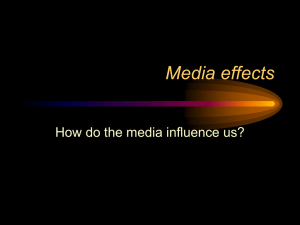
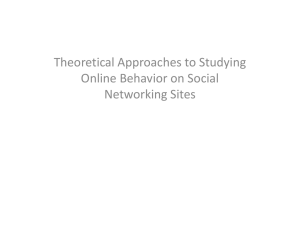
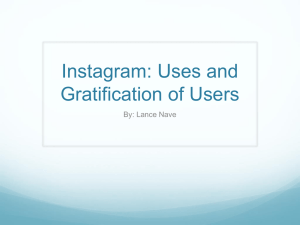
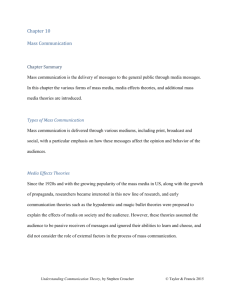
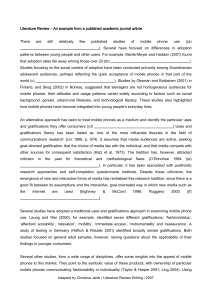
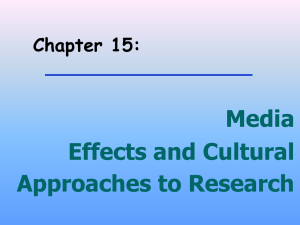
![Cultural_Studies[1]](http://s2.studylib.net/store/data/005410422_1-af7d49e7f1af52657d80c09bf57251ef-300x300.png)
